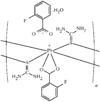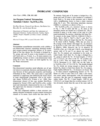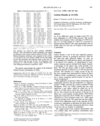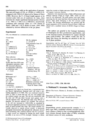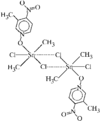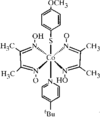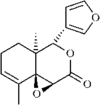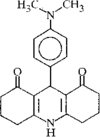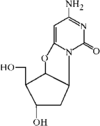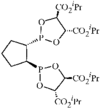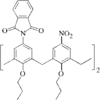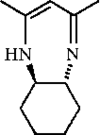issue contents
July 1998 issue

Cover illustration: [Ph4P]2[Sb2S15], see Rijnberk, Näther, Schur, Jess & Bensch, pages 920-923. The [Sb2S15]2- anion is shown with displacement ellipsoids plotted at the 50% probability level.
cif-access (inorganic compounds)
Download citation


Download citation


Na4[Fe(CN)6].10H2O crystallizes with the Fe atom lying on an inversion centre and the cyano groups in a regular octahedral arrangement around it. The water molecules form a hydrogen-bonded network and are arranged around the Na atoms.
cif-access (metal-organic compounds)
Download citation


Download citation


The repeating unit in this polymeric structure involves both thiourea ligands and one 2-fluorobenzoate ligand. The Pb atom is coordinated by four O atoms from three 2-fluorobenzoate ligands and four S atoms from four thiourea ligands. The Pb⋯Pb separation is 3.74 Å. The many hydrogen bonds include three-centered hydrogen bonds involving C-F bonded F atoms.
cif-access (organic compounds)
Download citation


Download citation


The structure of the cholic acid–methanol–water inclusion complex is similar to that of cholic acid with methanol [Jones & Nassimbeni (1990). Acta Cryst. B46, 399-405]. The methanol guest is hydrogen bonded to the water molecule, which in turn participates in hydrogen bonds with three of the cholic acid O atoms.
Download citation


Download citation


Cedranediol, (1R,2R,5S,7R,8R,9S)-2,6,6,8-tetramethyltricyclo-[5.3.1.01,5]undecane-8,9-diol, has been synthesized and characterized by X-ray diffraction analysis. It is a new chiral auxiliary for asymmetric homologation.
Download citation


Download citation


The title compound, synthesized from the [2+2] cycloaddition of dichloroketene with 1-(benzoyloxy)methyl-3-methyl-2-butene, is shown to have the benzoyloxymethyl group at the 4 position. The cyclobutanone ring is puckered with a 28.6(2)° fold angle.
Download citation


Download citation


The N-H group of the title molecule forms an intramolecular N-H⋯N hydrogen bond [N⋯N 2.836 (3) Å] and is shielded from possible intermolecular acceptors by the SiMe3 groups.
Download citation


Download citation


The azapurine base has a slight butterfly shape with a 4.0 (3)o interplanar angle between the five-membered triazolo and six-membered pyrimidine rings. The β-D-xylopyranosyl ring has a 4C1 conformation.
Download citation


Download citation


The pyrrolidine ring has a twist conformation with a pseudo-twofold axis passing through the N atom. The crystal packing is stabilized by an intermolecular hydrogen bond.
inorganic compounds
Download citation


Download citation


Ta4O(Te2)4TeI4 contains Ta4O clusters in the form of distorted oxygen-centred tetrahedra. Neighbouring pairs of Ta4O clusters are linked by a μ4 Te atom to form a one-dimensional chain structure.
Download citation


Download citation


Hexakis(tetratelluriotantalum) tetraiodide hexaiodotantalate has a [TaTe4]n chain structure with TaI6− complex anions and I− anions between the chains. The [TaTe4]n chain contains rectangular antiprismatic TaTe8 polyhedra, each Ta atom being coordinated by four Te2 groups.
Download citation


Download citation


The single crystal of CO2 at 1.00 (5) GPa pressure exhibits Pa-3 symmetry with a = 5.4942 (2) Å and a C-O bond length of 1.168 (1) Å (corrected for thermal motion effects). The study demonstrates that an earlier claim of a new dry ice II phase at this pressure is unfounded.
Download citation


Download citation


Nb9AsO25 is isostructural with Nb9PO25 (I4/m). The structure contains 3 × 3 ReO3-type columns of distorted NbO6 octahedra.
Download citation


Download citation


Lithium trithioarsenate, a new member of the M3AX3 group of compounds, contains AsS3 pyramids in which all the S atoms are non-bridging. The Li atoms form LiS4 tetrahedra and LiS3+2 distorted trigonal bipyramids.
Download citation


Download citation


The reaction of Rb2S3, NbO and S yields single crystals of Rb3NbS4 with the K3VS4 structure type. The structure is based on Rb+ cations and discrete tetrahedral NbS43− anions.
metal-organic compounds
Download citation


Download citation


Download citation


Download citation


Download citation


Download citation


Download citation


Download citation


Download citation


Download citation


Download citation


Download citation


Download citation


Download citation


Download citation


Download citation


Download citation


Download citation


Download citation


Download citation


Download citation


Download citation


Download citation


Download citation


Download citation


Download citation


Download citation


Download citation


Download citation


Download citation


Download citation


Download citation


Download citation


Download citation


Download citation


Download citation


Download citation


Download citation


Download citation


Download citation


Download citation


Download citation


organic compounds
Download citation


Download citation


Download citation


Download citation


Download citation


Download citation


Download citation


Download citation


Download citation


Download citation


Download citation


Download citation


Download citation


Download citation


Download citation


Download citation


Download citation


Download citation


Download citation


Download citation


Download citation


Download citation


Download citation


Download citation


Download citation


Download citation


Download citation


Download citation


Download citation


Download citation


Download citation


Download citation


Download citation


Download citation


Download citation


Download citation


Download citation


Download citation


Download citation


Download citation


Download citation


Download citation


Download citation


Download citation


Download citation


Download citation


Download citation


Download citation


Download citation


Download citation


Download citation


Download citation


Download citation


Download citation


Download citation


Download citation


Download citation


Download citation


Download citation


Download citation


Download citation


Download citation


Download citation


Download citation


Download citation


Download citation


Download citation


Download citation


Download citation


Download citation


Download citation


Download citation


Download citation


Download citation


Download citation


Download citation


Download citation


Download citation


Download citation


Download citation


Download citation


Download citation


Download citation


Download citation


Download citation


Download citation


Download citation


Download citation




 journal menu
journal menu












